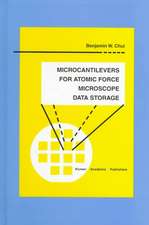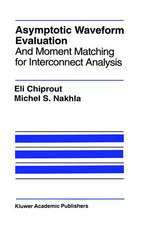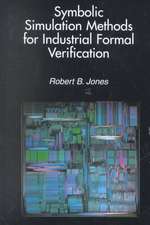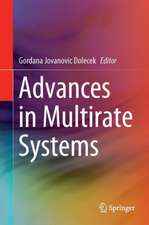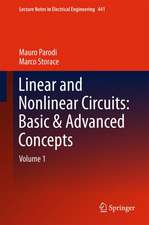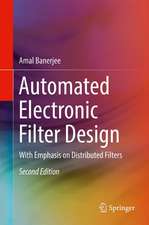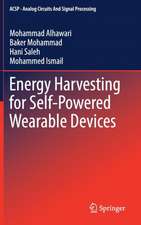The Designer's Guide to Jitter in Ring Oscillators: The Designer's Guide Book Series
Autor John A. McNeill, David Rickettsen Limba Engleză Hardback – 28 apr 2009
| Toate formatele și edițiile | Preț | Express |
|---|---|---|
| Paperback (1) | 835.77 lei 6-8 săpt. | |
| Springer Us – 9 dec 2010 | 835.77 lei 6-8 săpt. | |
| Hardback (1) | 644.95 lei 6-8 săpt. | |
| Springer Us – 28 apr 2009 | 644.95 lei 6-8 săpt. |
Preț: 644.95 lei
Preț vechi: 758.77 lei
-15% Nou
Puncte Express: 967
Preț estimativ în valută:
123.41€ • 128.85$ • 102.14£
123.41€ • 128.85$ • 102.14£
Carte tipărită la comandă
Livrare economică 04-18 aprilie
Preluare comenzi: 021 569.72.76
Specificații
ISBN-13: 9780387765266
ISBN-10: 0387765263
Pagini: 276
Ilustrații: XX, 276 p. 140 illus.
Dimensiuni: 155 x 235 x 18 mm
Greutate: 0.54 kg
Ediția:2009
Editura: Springer Us
Colecția Springer
Seria The Designer's Guide Book Series
Locul publicării:New York, NY, United States
ISBN-10: 0387765263
Pagini: 276
Ilustrații: XX, 276 p. 140 illus.
Dimensiuni: 155 x 235 x 18 mm
Greutate: 0.54 kg
Ediția:2009
Editura: Springer Us
Colecția Springer
Seria The Designer's Guide Book Series
Locul publicării:New York, NY, United States
Public țintă
Professional/practitionerCuprins
to oscillator jitter.- Classification of ring oscillators.- Phase-Locked Loop System Concepts.- Overview of Noise Analysis Fundamentals.- Measurement Techniques.- Analysis of jitter in ring oscillators.- Sources of jitter in ring oscillators.- Design methodology.- Low jitter VCO design examples.
Textul de pe ultima copertă
The Designer’s Guide to Jitter in Ring Oscillators provides information for engineers on designing voltage controlled oscillators (VCOs) and phase-locked loops (PLLs) for low jitter applications such as serial data communication and clock synthesis. The material is presented in a clear, intuitive fashion at both the system level and the circuit level to help designers improve their understanding of fundamental noise sources and design low jitter circuitry within power, area, and process constraints so that ultimate performance meets system level requirements.
At the system level, the authors describe and specify different methods of measuring jitter to characterize time domain uncertainty. Although the emphasis is on time-domain measures of oscillator performance, a simple method of translating performance to frequency domain (phase noise) measures is also included.
At the circuit level, the authors include techniques for design of low jitter delay elements for use in ring oscillators, as well as relating the circuit-level characteristics to system-level performance. The authors discuss a classification scheme for delay stages to help guide the designer’s choice with regard to signal type (single-ended vs. differential), output format (single phase vs. multiple phase), and tuning method. Simple mathematical expressions are developed describing the noise-power tradeoffs for each type of stage, so the designer can quickly estimate the power dissipation required to achieve a desired level of jitter.
The Designer’s Guide to Jitter in Ring Oscillators is an excellent resource for engineers and researchers interested in jitter and ring oscillators and their application in communication systems.
At the system level, the authors describe and specify different methods of measuring jitter to characterize time domain uncertainty. Although the emphasis is on time-domain measures of oscillator performance, a simple method of translating performance to frequency domain (phase noise) measures is also included.
At the circuit level, the authors include techniques for design of low jitter delay elements for use in ring oscillators, as well as relating the circuit-level characteristics to system-level performance. The authors discuss a classification scheme for delay stages to help guide the designer’s choice with regard to signal type (single-ended vs. differential), output format (single phase vs. multiple phase), and tuning method. Simple mathematical expressions are developed describing the noise-power tradeoffs for each type of stage, so the designer can quickly estimate the power dissipation required to achieve a desired level of jitter.
The Designer’s Guide to Jitter in Ring Oscillators is an excellent resource for engineers and researchers interested in jitter and ring oscillators and their application in communication systems.
Caracteristici
Emphasizes jitter for time domain applications so that there is not a need to translate from frequency domain Provides a more direct path to the results for designing in an application area where performance is specified in the time domain Includes classification of oscillator types and an exhaustive guide to existing research literature which allows designers to find appropriate publications for more detailed design guidance Covers the classification of measurement techniques to help designers understand how the eventual performance of circuit design is verified





